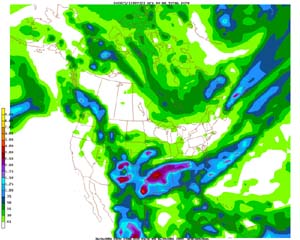| NOAA Magazine || NOAA Home Page |
NOAA ANNOUNCES NEW INTERNATIONAL MONSOON RESEARCH PROGRAM
 June
25, 2004 — NOAA and Mexico's weather
service, the Servicio Meteorologico
Nacional, have joined forces to develop improved monsoon season forecasts.
The initial phase of the North
American Monsoon Experiment, or NAME, an internationally coordinated,
joint U.S.-Mexico program, begins this month. The aim of the program is
to improve long-range precipitation forecasts during the North American
monsoon season of June through September. (Click NOAA image for
larger view of 120-hour precipitation outlook, for June 24-29, 2004, showing
strong rainfall potential developing in New Mexico with the new backdoor
cold front that moves into central and southern New Mexico after 24 hours,
including 60-hour precipitation totals. The 5-day forecast indicates rainfall
will exceed two to three inches in sections of south-central New Mexico.
Click here for high
resolution version, which is a large file. Please credit “NOAA.”)
June
25, 2004 — NOAA and Mexico's weather
service, the Servicio Meteorologico
Nacional, have joined forces to develop improved monsoon season forecasts.
The initial phase of the North
American Monsoon Experiment, or NAME, an internationally coordinated,
joint U.S.-Mexico program, begins this month. The aim of the program is
to improve long-range precipitation forecasts during the North American
monsoon season of June through September. (Click NOAA image for
larger view of 120-hour precipitation outlook, for June 24-29, 2004, showing
strong rainfall potential developing in New Mexico with the new backdoor
cold front that moves into central and southern New Mexico after 24 hours,
including 60-hour precipitation totals. The 5-day forecast indicates rainfall
will exceed two to three inches in sections of south-central New Mexico.
Click here for high
resolution version, which is a large file. Please credit “NOAA.”)
"These forecast improvements would have tremendous implications for NOAA's ability to monitor and predict drought, months in advance, especially in areas such as the desert Southwest, where water is relatively scarce," said Louis W. Uccellini, director of the NOAA National Centers for Environmental Prediction. The NAME program is fostering a two-way exchange of information, technology and training between the NOAA National Weather Service and Mexico's Servicio Meteorologico Nacional.
The eight-year program has set far-reaching goals in operational climate forecasting. This year, the NAME 2004 Field Campaign will gather atmospheric, oceanic and land-surface observations in the core region of North American monsoons—northwest Mexico, southwest U.S. and adjacent oceanic areas. The Field Campaign involves scientists from more than 30 universities, government laboratories and federal agencies in the U.S., Mexico and Central America. It includes more than 25 scientists from the NOAA National Weather Service. The program also involves the National Science Foundation, NASA, and the U.S. departments of Agriculture and Defense.
"The 2004 Field Campaign will improve our understanding of the daily cycle of precipitation in the complex terrain of the core monsoon region," said Wayne Higgins, lead scientist for NAME and the principle climate scientist at the NOAA Climate Prediction Center.
Summer monsoons are seasonal reversals of wind direction that occur in response to temperature differences between the land and sea, accompanied by increases and decreases in precipitation, and can occur over all low-latitude continental regions.
The North American monsoon, though much weaker than the Asian monsoon, exerts a strong influence on the precipitation, temperature and wind patterns in the core monsoon region but also over much of the western half of North America and adjacent ocean areas.
"In many countries the arrival of the summer monsoon rainfall is good news since it replenishes the waterways and provides a critical supply of water for agriculture and other economic concerns," said Higgins. "But every few years, excessive rains cause serious flooding."
A weaker
monsoon season can worsen water shortages leaving fields and waterways
parched and dry and the region more susceptible to large-scale forest
fires. Because acute weather conditions associated with monsoons, like
floods and drought, can wreak havoc on a region's economy and population,
monsoons need to be accurately understood and predicted by weather and
climate models. The improved forecasts will give communities more time
to plan for the conditions.
The NOAA National Weather Service is the primary source of weather data,
forecasts and warnings for the United States and its territories. The
NOAA Weather Service operates the most advanced weather and flood warning
and forecast system in the world, helping to protect lives and property
and enhance the national economy.
NOAA is dedicated to enhancing economic security and national safety through the prediction and research of weather and climate-related events and providing environmental stewardship of the nationís coastal and marine resources. NOAA is part of the U.S. Department of Commerce.
Relevant
Web Sites
North
American Monsoon Experiment, or NAME
NOAA National Centers for Environmental
Prediction
NOAA Climate Prediction Center
North American Monsoon Experiment: University Corporation for Atmospheric Research (UCAR)
Media
Contact:
Carmeyia Gillis, NOAA
Climate Prediction Center, (301) 763-8000 ext. 7163